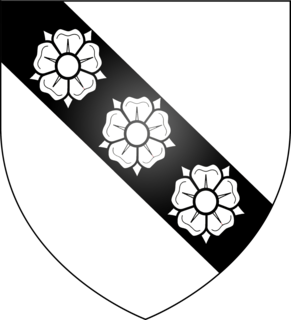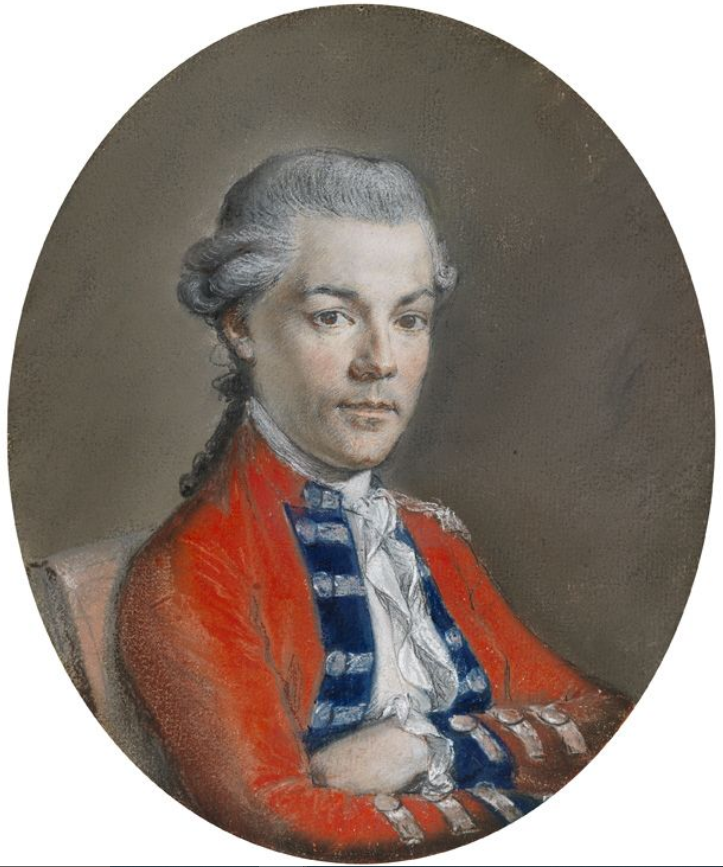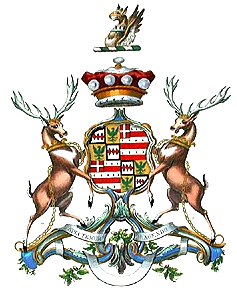Related Research Articles

The Palace of Beaulieu is a former Royal Palace in Boreham, Essex, England, north-east of Chelmsford. The surviving part is a Grade I listed building. The property is currently occupied by New Hall School.

Earl of Cardigan is a title in the Peerage of England, currently held by the Marquesses of Ailesbury, and used as a courtesy title by the heir apparent to that Marquessate, currently David Brudenell-Bruce, Earl of Cardigan, son of the 8th Marquess. The Brudenell family descends from Sir Robert Brudenell, Chief Justice of the Common Pleas from 1520 to 1530. His great-grandson, Sir Thomas Brudenell, was created a Baronet in the Baronetage of England, styled "of Deene in the County of Northampton", on 29 June 1611. On 26 February 1628, he was raised to the Peerage of England as Baron Brudenell, of Stanton Wyvill in the County of Leicester, and on 20 April 1661 he was further honoured when he was made Earl of Cardigan, also in the Peerage of England. On his death, the titles passed to his son, Robert, the 2nd Earl, and on the 2nd Earl's death to his grandson, George, the 3rd Earl, the 2nd Earl's only son, Francis, Lord Brudenell, having predeceased his father.

Viscount Falmouth is a title that has been created twice, first in the Peerage of England, and then in the Peerage of Great Britain. The first creation came in the Peerage of England in 1674 for George FitzRoy, illegitimate son of King Charles II by Barbara Villiers. He was created Earl of Northumberland at the same time and in 1683 he was made Duke of Northumberland. However, he left no heirs, so the titles became extinct at his death in 1716.

Earl of Chichester is a title that has been created three times in British history. The current title was created in 1801 for Thomas Pelham, 2nd Baron Pelham of Stanmer in the Peerage of the United Kingdom.

Earl of Verulam is a title in the Peerage of the United Kingdom. It was created in 1815 for James Grimston, 4th Viscount Grimston. He was made Viscount Grimston at the same time. Verulam had previously represented St Albans in the House of Commons. In 1808 he had also succeeded his maternal cousin as tenth Lord Forrester. He was succeeded by his son, the second Earl. He was a Tory politician and held minor office in the first two governments of the Earl of Derby. His son, the third Earl, represented St Albans in Parliament as a Conservative. His grandson, the sixth Earl was nominated to the traditionally safe seat of St Albans for the party. As of 2017 the titles are held by his son, the seventh Earl, who succeeded in 1973.

Baron Annaly is a title that has been created three times, twice in the Peerage of Ireland and once in the Peerage of the United Kingdom. Annaly is named after the ancient term for the general locale, which in turn was named after the original ancient king. The third creation is currently extant.

Baron Hunsdon is a title that has been created three times.
Earl Beaulieu, of Beaulieu in the County of Southampton, was a title in the Peerage of Great Britain. It was created in 1784 for the 1st Baron Beaulieu, who had earlier represented Tiverton in the House of Commons. He had previously been created Baron Beaulieu, of Beaulieu in the County of Southampton, in 1762, also in the Peerage of Great Britain.

Earl of Carhampton was a title in the Peerage of Ireland. It was created in 1785 for Simon Luttrell, 1st Viscount Carhampton. He had already been created Baron Irnham, of Luttrellstown in the County of Dublin, in 1768 and Viscount Carhampton, of Castlehaven in the County of Cork, in 1781, also in the Peerage of Ireland. He was the son of Henry Luttrell. Lord Carhampton was succeeded by his eldest son, the second Earl. He was a General in the British Army and served as Commander-in-Chief of Ireland from 1796 to 1798. He was childless and was succeeded by his younger brother, the third Earl. He was a Captain in the Royal Navy and also sat as Member of Parliament for Stockbridge. He married as his first wife the Honourable Elizabeth Olmius, daughter of John Olmius, 1st Baron Waltham, and assumed in 1787 by Royal Licence the additional surname of Olmius. Lord Carhampton had no sons and the titles became extinct on his death in 1829. Already the same year George IV offered to revive the earldom in favour of Sir Simeon Stuart, 5th Baronet, son of Sir Simeon Stuart, 4th Baronet, and his wife Lady Frances Maria, daughter of the third Earl. However, the offer was declined.

Earl Cornwallis was a title in the Peerage of Great Britain. It was created in 1753 for Charles Cornwallis, 5th Baron Cornwallis. The second Earl was created Marquess Cornwallis but this title became extinct in 1823, while the earldom and its subsidiary titles became extinct in 1852. The Cornwallis family descended from Frederick Cornwallis, who represented Eye and Ipswich in the House of Commons. He was created a Baronet in the Baronetage of England in 1627 and Baron Cornwallis, of Eye in the County of Suffolk, in the Peerage of England in 1661. He was succeeded by his son, the second Baron. He also sat as Member of Parliament for Eye. On his death the titles passed to his son, the third Baron. He notably served as First Lord of the Admiralty. His son, the fourth Baron, was Lord Lieutenant of Suffolk and Postmaster General.
Earl of Glandore, in the County of Kerry, was a title in the Peerage of Ireland. It was created in 1776 for the Irish politician William Crosbie, 2nd Baron Brandon.
Earl of Catherlough was a title in the Peerage of Ireland.

Edward Hussey-Montagu, 1st Earl Beaulieu, KB was a British peer and politician.

Baron Wentworth is a title in the Peerage of England. It was created in 1529 for Thomas Wentworth, who was also de jure sixth Baron le Despencer of the 1387 creation. The title was created by writ, which means that it can descend via female lines.

Earl Ligonier was a title that was created twice in British history, once in the Peerage of Great Britain and once in the Peerage of Ireland. The first creation came in the Peerage of Great Britain on 10 September 1766 in favour of the French-born soldier Field Marshal John Ligonier. The peerage was created with normal remainder to the heirs male of his body. He had already been created Viscount Ligonier, of Enniskillen, in the Peerage of Ireland on 31 December 1757, with normal remainder to the heirs male of his body, and Viscount Ligonier, of Clonmell, in the Peerage of Ireland on 20 May 1762, with remainder to his nephew, Edward Ligonier. In 1763 he was also created Lord Ligonier, Baron of Ripley, in the County of Surrey, in the Peerage of Great Britain, with normal remainder to the heirs male of his body. The barony, viscountcy of 1757 and earldom became extinct on his death on 28 April 1770 while he was succeeded in the viscountcy of 1762 according to the special remainder by his nephew, the second Viscount. Edward Ligonier was the illegitimate son of Colonel Francis Augustus Ligonier, brother of the first Earl. On 19 July 1776 the earldom was revived when he was made Earl Ligonier, of Clonmell in the County of Tipperary, in the Peerage of Ireland. The titles became extinct on his death on 14 June 1782.
Simon Luttrell, 1st Earl of Carhampton, was an Anglo-Irish politician who sat in the House of Commons from 1754 to 1780.
Drigue Billers Olmius, 2nd Baron Waltham, was a British politician.
Captain John Luttrell-Olmius, 3rd Earl of Carhampton, styled The Honourable John Luttrell between 1768 and 1787 and as The Honourable John Luttrell-Olmius between 1787 and 1829, was an Irish naval commander and politician who sat in the House of Commons between 1774 and 1785.

John Olmius, 1st Baron Waltham, of New Hall, Boreham, Essex, was a British landowner and Whig politician who sat in the House of Commons between 1737 and 1762.

Earl of Arran is a title in the Peerage of Ireland. It is not to be confused with the title Earl of Arran in the Peerage of Scotland. The two titles refer to different places: the Aran Islands in Ireland, and the Isle of Arran in Scotland. The Irish earldom is held by the Gore family. The Scottish earldom is a separate title, held as a subsidiary title of the Duke of Hamilton.